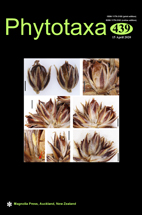Abstract
Tiganophyton karasense, an evergreen dwarf shrub, is described as a new species. A new genus and family are also proposed for it in the order Brassicales. Phylogenetic analysis of DNA sequence data indicate that Tiganophyton is sister to Bataceae/Salvadoraceae, and all three sister to Koeberliniaceae. First realized to be undescribed in 2010, T. karasense is a rare species known only from three localities in the arid Karas Region, southern Namibia. These small shrubs grow near the edges of seasonal pans on calcareous substrate underlaid by shales and mudstones of the Prince Albert Formation of the Karoo Supergroup. Morphological characters diagnostic of the new family include: a marked differentiation into long and short shoots; dimorphic, spirally arranged leaves; glucosinolate production; bisexual laterally flattened flowers borne singly in bract axils on short shoots only; tetramerous calyx, corolla and androecium with fused sepals and free, non-clawed petals; a staminal disc, but no nectary glands; deeply bilobed ovary with a gynobasic style; S-shaped gynophore supporting a bilocular, horizontally orientated or inverted ovary; two ovules per locule; and a dry, persistent fruit, provisionally interpreted as a one-seeded nutlet. Based on IUCN Red List categories and criteria, a conservation assessment of Vulnerable (VU D1) is recommended for Tiganophyton karasense.

